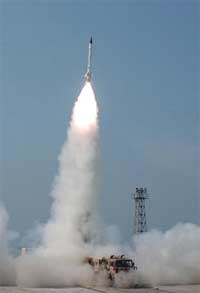Phase One of Indian BMD programme on track for completion by 2011
10 Mar 2009
New Delhi: The Defence Research and Development Organisation (DRDO) said Monday plans to develop the country's ballistic missile programme were on course and the first phase would be completed by 2011. Senior DRDO official, Dr VK Saraswat, said two more tests would be conducted to conclude this phase of the programme.
 With the successful third ballistic missile interceptor flight-test already conducted on Friday at the integrated test range, chief controller (Missiles Strategic Systems) and Programme Director (Air Defence), Dr VK Saraswat said, ''The third consecutive interception of ballistic missile demonstrated the robustness of the Indian BMD system. The DRDO have already conducted two interception trials, first in exo-atmospheric region at 48 km altitude on 27 November 2006 and the second in endo-atmospheric region at 15 km using AAD missile on 6 December 2007,'' he said.
With the successful third ballistic missile interceptor flight-test already conducted on Friday at the integrated test range, chief controller (Missiles Strategic Systems) and Programme Director (Air Defence), Dr VK Saraswat said, ''The third consecutive interception of ballistic missile demonstrated the robustness of the Indian BMD system. The DRDO have already conducted two interception trials, first in exo-atmospheric region at 48 km altitude on 27 November 2006 and the second in endo-atmospheric region at 15 km using AAD missile on 6 December 2007,'' he said.
Briefing journalists, Dr. Saraswat said an integrated endo- and exo-atmospheric test was on the cards and very likely would be conducted by the end of this year.
Under the first phase of the programme the Indian BMD system would develop the capability to intercept incoming missiles with a range of 2000-km. Saraswat said, ''It will take five tests (three already conducted) to validate BMD capabilities to destroy ballistic missiles of 2,000 km range. We will then work on interceptor missiles that can engage aggressor missiles with longer ranges.''
The United States, Israel and Russia have already offered their equivalent systems to India. The American's are touting their Patriot air defence system, Israeli's the Arrow-2 BMD system and the Russian's the S-300V surface-to-air missiles.
These offers are yet to impress the DRDO, however. According to Dr Saraswat, ''BMD is a hi-tech and complex subject…it has to be indigenously developed. You cannot beg, borrow or steal it from someone. It won't be suitable for your country. The DRDO's BMD architecture has been customised to the Indian threat profile…The AAD is 20 per cent superior to PAC-3.''
He said the DRDO had sought foreign collaboration only for bridging technological gaps and accelerating technology development. The long-range tracking radars (LRTR) used for detecting targets for the interceptor missiles are modified Israeli Green Pine radars. The interceptor missiles use an indigenized Russian radio frequency seeker and the fire control radar is French. The LRTR currently has a range of 600 km, which the DRDO plans to upgrade to 1,500 km by 2011.
Under the second phase, capabilities would be enhanced to engage intercontinental ballistic missiles, with a range of over 3,500 km.
Responding to questions, Dr Saraswat said the interceptor used in the Friday test was guided by an Inertial Navigation System in mid course flight and used a radio frequency homing seeker in the terminal phase to destroy the incoming missile.




















